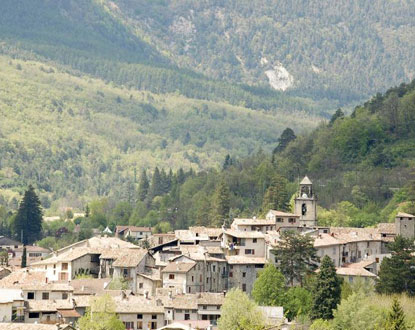The most practical way to reach this large village is still the Train des Pignes. The first steam train, La Georgette, after a four-hour journey, arrived on June 27, 1908, from Nice. It took until 1911 for the Colle Saint Michel tunnel and the Beïte viaduct to allow a direct connection with Digne les Bains.
Previously, it was the transshipment with Léotardi Transport Company’s stagecoach that made the shuttle between the two sections of the railway. Annot was opening up to communications, after being isolated in the depths of its valley between the Vaïre and the Beïte. Annot, along with Entrevaux, was a strategic point, first for Provence, then for the Kingdom of France at the end of the 15th century. The town would experience three expansions of its fortified belt.
In the Middle Ages, Mazel Street was where the butcheries, with animal slaughtering, were located. It was in this narrow street that Jean André, an artist painter, was born in 1612. Saint John Street was the main artery in the 12th century. It started from the Roubine gate and led to the church of Saint John the Baptist, the first patron protector of the commune. This gate, from 1182, would be removed two centuries later with the new ramparts. Saint Martin’s tower was part of the first 12th-century belt.
The 14th century marked an important boom for Annot with the town’s expansion. The Grand Rue then became the way where commerce and stately homes lined up. It wasn’t until the 15th century that a washhouse dedicated to Saint Martin was established. The Place de la Gléio, also known as the place of the community, was where the communal council was elected for a year at Easter. Besides the church, there was the town hall and a cemetery on this square. From the 14th century, Place Notre Dame was the location for public celebrations. There were also other, more risqué activities, with Capone Street housing a brothel at the same time.
In the 16th century, new ramparts were erected, and the Tour gate would be destroyed in 1860 after the annexation of the Savoy and the County of Nice to France, thus moving the border away from newly unified Italy. The Rabiers de Villars de Chateauredon house, the winter residence of this noble family, is also noteworthy. The ground floor served the king’s, the emperor’s, and the republic’s gendarmes until the early 1900s.
We previously mentioned the church of Saint John the Baptist, also dedicated to Saint Pons, whose foundations date back to 1010. It was enlarged until the 16th century, with its bell tower and the four evangelists serving as a watchtower. The chapel of the White Penitents, Our Lady of Mercy, is located very nearby. Inside, one can admire a piece by François Mimault from 1641. The Argentoun path is believed to have been the old Roman road. Also discovered are flour and oil mills, with walnut trees being abundant in the 19th century.
There are three squares that marked Annot’s history: the Square of Mills with its Genty family sawmill, dye works, and drapers, was very industrious until the end of World War I. The Coulet Square or “little hill,” where barns and stables were found until 1914. Finally, the Grand market Square (Grando dou Marcat). In 1388 Queen Marie granted the privilege of tax-free markets. Annot also had silkworm farms starting from the 16th century. There were also tile factories where tiles and kitchen utensils were made. Mentioned was Jean André, a 17th-century artist; Annot had other famous sons, including Jacques Verdolin, a lawyer, notary, and alderman (1738-1793) who sat in the Estates-General, refused the death of Louis XVI, defended the Provençal language, and contributed to the drafting of the Declaration of the Rights of Man.
To conclude, we will mention François Barra, a poet, musician, and luthier who entertained his community’s festivals for nearly twenty years. A discreet and modest man, a bit eccentric with this tympanum drawn by him on his house, he faded away, a bit like Brassens’ Martin, between Christmas and New Year’s in 1976.


